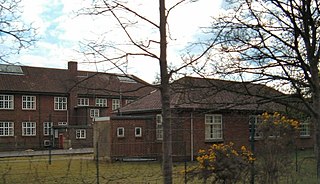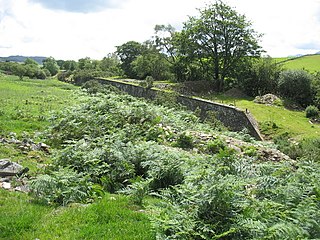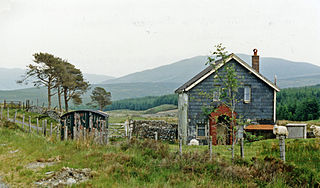
The West Coastway line is a railway line in England linking the densely populated conurbations of Brighton/Hove/Littlehampton and Southampton/Portsmouth, with 1.3 million people between them. It has short southward branches to Littlehampton and Bognor Regis. Some trains using part of the route operate as direct continuations of passenger services to/from London, particularly those to the branch stations mentioned.

The Longmoor Military Railway (LMR) was a British military railway in Hampshire, built by the Royal Engineers from 1903 in order to train soldiers on railway construction and operations. The railway ceased operation on 31 October 1969.

Liss railway station is a stop on the Portsmouth Direct Line, serving the village of Liss in Hampshire, England, 51 miles 35 chains (82.8 km) down the line from London Waterloo via Woking. As a small station, for most of the day there is one train each way an hour. The station is managed by South Western Railway, which operates all trains serving it.
The Bordon Light Railway was a short-lived light railway line in Hampshire that connected the Army Camp at Bordon, as well as the villages of Bordon and Kingsley, with the national rail network at Bentley on the main Farnham-Alton line, a distance of 4.5 miles (7.2 km).
Milton Range Halt was a halt between Denton Halt and Hoo Junction Staff Halt on the Hundred of Hoo Railway. It opened in July 1906 and closed to public use on 17 September 1932, although it remained open by special arrangement after that date until some time after 1956. It served Milton Range rifle range.

Kelmscott and Langford railway station was a railway station south of the village of Langford on the Oxford, Witney and Fairford Railway, between Oxford and Fairford.
Towiemore Halt railway station served the hamlet of Towiemore and its distillery as a private and later as a public halt in Moray, Scotland, from 1937 to 1968 on the Keith and Dufftown Railway. The line was re-opened in 2001 and the station is now a request stop.
The Brill Tramway, also known as the Quainton Tramway, Wotton Tramway, Oxford & Aylesbury Tramroad and Metropolitan Railway Brill Branch, was a six-mile (10 km) rail line in the Aylesbury Vale, Buckinghamshire, England. It was privately built in 1871 by the 3rd Duke of Buckingham as a horse tram line to transport goods between his lands around Wotton House and the national railway network. Lobbying from residents of the nearby town of Brill led to the line's extension to Brill and conversion to passenger use in early 1872. Two locomotives were bought for the line, but as it had been designed and built with horses in mind, services were very slow; trains travelled at an average speed of only 4 miles per hour (6.4 km/h).
Oakhanger Halt is a former railway station, on the Longmoor Military Railway which served Bordon Camp, the station was closer to the camp than Bordon on the Bordon Light Railway. The station is likely to have opened with the line in 1905 but the first documented evidence showing it open is on 14 August 1914 when it was used the Officer Commanding Railway Troops to say goodbye to the first mobilised Railway Company departing for France.
Woolmer railway station is a former railway station, on the Longmoor Military Railway which served the hamlet of Woolmer. The station was probably situated opposite the end of what is now Blackmoor Road, the station is shown as existing on a 1933 map but its precise location is not shown.
Weaversdown Halt railway station is a former railway station, on the Longmoor Military Railway, which served the eastern side of Longmoor Military Camp. The station did not appear on Ordnance Survey mapping throughout its life and did not have signs on the platform, it was variously known as Weaversdown, Weavers Down and Weaver Down sometimes with the additional Junction and sometimes with Halt.
Liss Forest Road railway station served the hamlet of Liss Forest neighbouring the larger village of Liss, in Hampshire. It is situated adjacent to Forest Road which runs from the A3 to Liss Forest. The road was crossed by a level crossing controlled by a block post, the Army's name for a signal box, which was usually un-staffed unless training was in progress.

Longmoor Downs railway station is a former railway station, on the Longmoor Military Railway serving Longmoor Military Camp. The station was the Southern terminus of the original standard gauge railway opened in stages between 1907 and 1908.

Bordon and Longmoor Military Camps are British Army training camps close to the A3 and A325 roads in and around the settlements of Bordon, Longmoor, Liss and Liphook in Hampshire, England. The main street of the Longmoor part of the camp is built on an ancient Roman road, the Chichester to Silchester Way, while the village of Greatham lies to the west. The combined camp and training area coveres 1,783 hectares of wooded areas, heath, wetlands and hard standings. Longmoor camp and the training areas are still active, and maintained by the Defence Infrastructure Organisation.
Bryn-Celynog Halt was an unstaffed solely passenger railway station which served the rural area of Bryn-Celynog, east of Trawsfynydd, Gwynedd, Wales.

Lowton railway station served the village named Town of Lowton to the east of Newton-le-Willows and south of Golborne.

Camerton Colliery Halt railway station was an unadvertised halt for workers at one or both of the collieries at Camerton, near Cockermouth in Cumberland, England.

Trawsfynydd Camp railway station, sometimes referred to as Trawsfynydd Military station served the Trawsfynydd Artillery range at Bronaber, south of Trawsfynydd in Gwynedd, Wales. The station never opened for civilian traffic.

Cwm Prysor Halt was a railway station which served the remote rural area of Cwm Prysor, east of Trawsfynydd, Gwynedd, Wales.
The Furness Railway and its antecedent companies had at different times a number of halts and non-public timetable stations. Halts were small, unstaffed stations with few, if any, facilities. Non-public timetable stations were stations that did not feature in the publicly advertised railway timetable and were, for example, for internal railway use only or only served by excursion trains rather than regular services.









